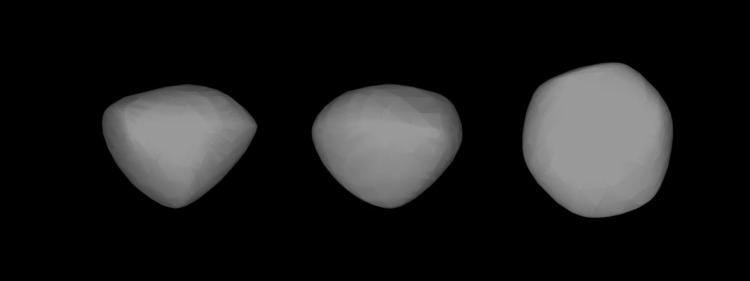Pronunciation /ˈsɪbᵻliː/ SIB-əl-ee Perihelion 459.654 Gm (3.073 AU) Spectral type C-type asteroid | Discovery date March 8, 1861 Aphelion 567.544 Gm (3.794 AU) Discovered 8 March 1861 Orbits Sun Asteroid group Cybele asteroid | |
 | ||
Minor planet category outer main belt (Cybele) Similar Wilhelm Tempel discoveries, Other celestial objects | ||
Asteroid 65 cybele
65 Cybele is one of the largest asteroids in the Solar System and is located in the outer asteroid belt. It gives its name to the Cybele family of asteroids that orbit outward from the Sun from the 2:1 orbital resonance with Jupiter. Cybele is a X-type asteroid, meaning that it is dark in color and carbonaceous in composition. It was discovered in 1861 by Ernst Tempel and named after Cybele, the earth goddess.
Contents
Discovery and naming
Cybele was discovered on March 8, 1861, by Ernst Tempel from the Marseilles Observatory. A minor controversy arose from its naming process. Tempel had awarded the honour of naming the asteroid to Carl August von Steinheil in recognition of his achievements in telescope production. Von Steinheil elected to name it "Maximiliana" after the reigning monarch Maximilian II of Bavaria. At the time, asteroids were conventionally given classical names, and a number of astronomers protested this contemporary appellation. The name Cybele was chosen instead, referring to the Phrygian goddess of the earth.
Physical characteristics
The first Cybelian stellar occultation was observed on October 17, 1979 in the Soviet Union. The asteroid appeared to have an irregular shape, with the longest chord being measured as 245 km, closely matching the diameter of 237 km determined by the IRAS satellite in 1983. During the same 1979 occultation, a hint of a possible 11 km wide satellite was detected.
The diameter from IRAS observations in 1983 is 237±4 km. In 1985, Green estimated Cybele to have a diameter of 330 km. In 2004, Müller estimated Cybele using thermophysical modelling (TPM) to have dimensions of 302×290×232 km.
In 2007, David Weintraub suggested that it might be in hydrostatic equilibrium, but it this is no longer considered a possibility.
Spectrum
Examination of the asteroid's infrared spectrum shows an absorption feature that is similar to the one present in the spectrum of 24 Themis. This can be explained by the presence of water ice. The asteroid may be covered in a layer of fine silicate dust mixed with small amounts of water-ice and organic solids.
Recent occultations
On August 24, 2008, Cybele occulted 2UCAC 24389317, a 12.7-magnitude star in the constellation Ophiuchus which showed a long axis of at least 294 km. On October 11, 2009, Cybele occulted a 13.4-magnitude star in the constellation Aquarius.
